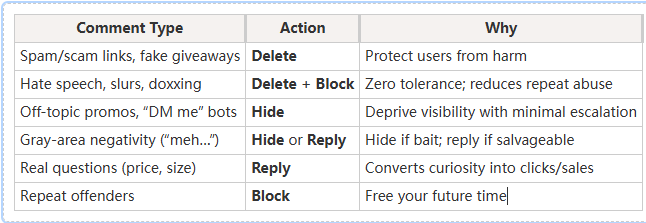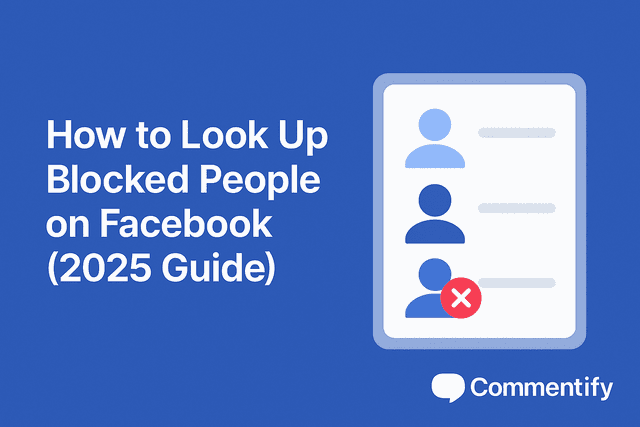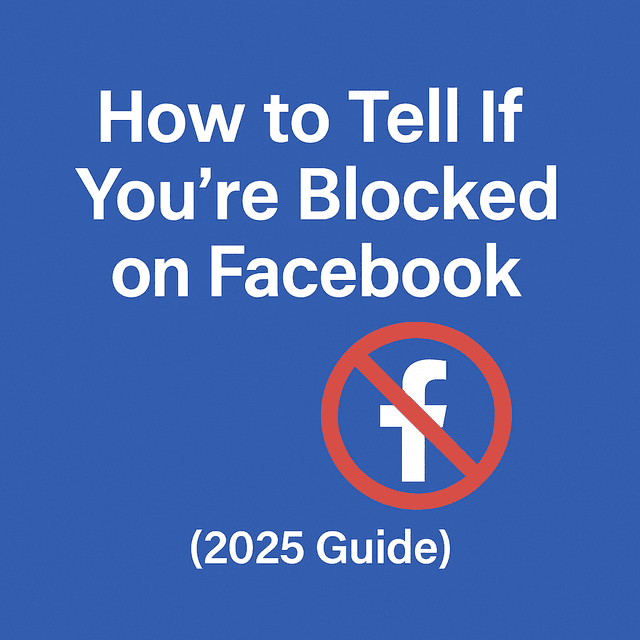How to Manage Comments on Facebook Ads (Complete 2025 Guide)
TABLE OF CONTENT
- Understanding Facebook and the Role of Ad Comments
- How to Manage Facebook Ad Comments
- Which Approach Should You Choose?
- Practical Playbooks You Can Copy
- Vertical-Specific Notes
- Metrics That Matter (So You Know It’s Working)
- Policy & Risk Alignment
- FAQs – Managing Facebook Ad Comments
- Conclusion: Protect ROI, Build Trust, and Keep the Conversation Useful
If you’ve ever run Facebook ads, you’ve seen it—spammy links, troll remarks, or even competitors hijacking your ad with self-promotion. On the flip side, you also see genuine feedback and potential customer questions. Left unmanaged, the comment section can become a liability, reducing your ad’s ROI and hurting your brand reputation.
This guide is your one-stop resource for understanding why Facebook ad comments matter, how to manage them effectively, and how to protect your brand using a combination of manual strategies and smart automation tools like Commentify.
Understanding Facebook and the Role of Ad Comments
Facebook isn’t just an ad platform; it’s a social space where users expect interaction and authenticity. When someone sees your sponsored post, they often look at the comments before deciding whether to click, buy, or trust you.
Why do comments exist on Facebook ads?
- Social Proof: A healthy comment section with positive engagement acts like testimonials. It reassures potential customers that others trust your brand.
- Engagement Signal: Comments drive discussion and help Facebook’s algorithm gauge relevance. Engaged posts can benefit from improved ad performance.
- Community Feedback: Users ask questions, share experiences, and even report issues—giving you valuable insights.
But there’s a flip side. Because ads are public, spam bots and trolls also see them. Without moderation, these comments can quickly spiral into a mess.
Story Example: A small skincare brand launched its first ad campaign. Within days, the comments were flooded with “Win an iPhone here” scam links. Prospective buyers started asking, “Is this brand legit?” CTR dropped by 30%. Only after cleaning up and responding to real questions did conversions recover.
How to Manage Facebook Ad Comments
A) Platform-Level (Native Facebook) Management
Facebook gives Page admins practical tools. Use these as your first layer:
- Hide vs. Delete (per comment) Hide = stealth. The commenter + their friends still see it; the public can’t. Use for off-topic, low-effort trolling, emoji floods, competitor promos, and bait. Delete = remove for everyone. Use for hate speech, slurs, doxxing, fraud/malware links, illegal claims.
- Keyword Blocklists (“Page moderation” / “Hidden words”) Preload spam phrases, profanity variants, and competitor promos. Facebook will auto-hide comments containing those words/phrases. Refresh this list weekly based on what you actually see in your vertical.
- Profanity Filter Set to Medium/Strong to auto-filter swears and obvious abusive language. Combine with your blocklist for better coverage.
- Where to moderate: Meta Business Suite → Inbox: Centralized view of comments across assets; reply, hide, or delete from one place. Ads Manager → Ad preview → “See post with comments”: Jump into the live ad post and moderate inline. Page notifications: Quick-tap triage for spikes, but less scalable.
- Team workflows inside Business Suite: Assign comments to teammates (“owner”), add labels/notes, and use Saved Replies to answer FAQs (e.g., shipping, pricing, returns) in seconds.
Strengths of native tools: Free, integrated, official, and safe.
Limitations: Reactive and manual by default; no robust sentiment detection; hard to scale across many ads/pages.
B) Manual Management (Your Playbook)
Manual doesn’t mean ad-hoc. Build a lightweight, repeatable system:
Daily routine (launch week):
- AM pass (15–30 min): Clear spam, answer buying questions, hide bait.
- Midday pass: Address new threads; pin 1 helpful reply (e.g., “Size chart & shipping times here ↗”).
- PM pass: Second sweep for evening traffic; escalate edge cases.
Reply framework:
- Genuine questions: Reply within 12–24h; add a link or helpful detail.
- Constructive criticism: Acknowledge + clarify + offer help (“We hear you; here’s how we can fix it. DM us order #.”).
- Misinformation: Correct calmly with facts; avoid snark.
- Trolling/derailment: Hide and move on.
Decision grid (print this):

Escalation:
- Legal/medical/financial claims → brand safety/legal review.
- Sensitive incidents → PR/comms.
- Product defect reports → CX/QA.
Pros of manual: Nuanced judgment; brand voice; builds goodwill by talking to buyers.
Cons: Time-intensive; can’t catch everything in real time.
C) Automated Management (AI with Commentify)
When volume spikes (multiple ad sets, cross-market launches, or always-on), AI does the heavy lifting and humans handle nuance.
Commentify.ai gives you:
- Real-time sentiment analysis to auto-flag/hide low-value or harmful comments.
- Keyword & pattern rules (e.g., hide comments with “DM me for…” variants).
- Bulk actions across Facebook + Instagram in one dashboard.
- Roles & audit logs for compliance (who hid what, when, and why).
- Multi-page, multi-account coverage.
Example rule set to start:
- Hide comments containing known spam phrases + short tag variants.
- Hide comments with >50% emojis or >3 identical emojis in a row.
- Flag comments containing shipping/refund keywords for human reply.
- Auto-delete comments with malware/fraud indicators (domains you blacklist).
- Flag sentiment ≤ −0.6 for moderator review; hide if confirmed.
Why layer AI on top of native tools: 24/7 vigilance; consistency; faster containment during ad surges; saves human time for actual buyers.
Which Approach Should You Choose?
Short answer: Use all three, staged.

Recommendation:
- Small spends or single-page tests: Native + Manual is fine.
- Always-on + multi-ad + multi-market: Add Commentify to avoid burnout and bad surprises.
- High-risk categories (finance/health): Use AI to catch issues early; escalate with a tight human loop.
Practical Playbooks You Can Copy
Pre-Launch (Day −7 to 0)
- Draft community guidelines (no spam, hate, scams; constructive feedback welcome).
- Build your keyword blocklist (competitor names, “giveaway,” “WhatsApp me,” crypto terms, phone/email formats).
- Populate Saved Replies (shipping times, returns, size chart, pricing).
- In Commentify: turn on baseline rules and sentiment thresholds.
Launch (Day 0–3)
- Three passes/day (AM, midday, PM).
- Pin one helpful reply (FAQ link or key benefit).
- Triage spikes: hide spam first, then reply to buyers.
- Tune Commentify rules based on what you see.
Scale (Day 4+)
- Move to two passes/day + AI guardrails.
- Weekly audit hidden items; rescue any false positives.
- Evolve blocklists; update Saved Replies from real FAQs.
- Review time-to-reply and conversion assists from comments.
Crisis Mode (if negativity spikes)
- Classify: Is this valid criticism or coordinated trolling?
- Act: Hide/delete policy violations immediately; reply once with facts; avoid back-and-forth.
- Escalate: PR/legal/comms where needed.
- Pause underperforming creatives if they attract disproportionate heat.
Vertical-Specific Notes
- E-commerce: Expect size/fit/returns chatter; pin sizing guides. Heavy emoji spam—auto-hide patterns.
- Apps/SaaS: Address pricing/feature gaps. Use Saved Replies with docs links; invite DMs for account-specific issues.
- Finance/Health: Be precise; avoid advice in comments. Hide misinformation; provide official resource links.
- Regulated industries: Keep audit logs (Commentify) and a written policy. Consistency matters if questioned.
Metrics That Matter (So You Know It’s Working)
Track before/after moderation changes:
- CTR and Outbound CTR: Often rise when threads are cleaner.
- Conversion Rate from ad traffic: Fewer bounce-offs from “comment anxiety.”
- Time-to-reply (median): Faster replies → higher trust.
- Spam removal rate and false-positive rate (weekly): Tune rules.
- Share of constructive vs. toxic comments: Health of discussion.
- Tickets reduced (fewer DMs or support emails due to public answers).
Policy & Risk Alignment
- Document your moderation policy (what gets hidden vs. deleted; escalation).
- Be consistent to avoid claims of arbitrary censorship.
- Avoid legal advice in comments; move sensitive issues to DMs or email.
- Use official integrations (Commentify does) to stay API-compliant.
FAQs – Managing Facebook Ad Comments
Q1: Can you turn off comments on Facebook ads?
No. You can’t disable comments outright on ads. Use hide/delete, blocklists, and profanity filters—and automation to scale.
Q2: Will commenters know if I hide their comment?
No. Facebook does not notify them. They (and their friends) still see it; the public does not.
Q3: When should I hide vs. delete a comment?
- Hide: Off-topic, bait, low-effort negativity, competitor plugs.
- Delete: Hate, slurs, doxxing, fraud, malware links, illegal claims.
Q4: Does hiding or deleting hurt ad reach?
Not directly. Cleaning spam often improves engagement quality and downstream performance.
Q5: Can I auto-hide comments by keyword?
Yes. Use Facebook’s keyword blocklist + profanity filter. For advanced logic and sentiment, use Commentify.
Q6: What happens to replies under a hidden comment?
They’re hidden from the public too (still visible to the commenter and their friends).
Q7: Should I reply to negative comments?
If they’re good-faith and specific: reply. If they’re bait/troll: hide. If harmful/illegal: delete and block.
Q8: How fast should I respond to buyer questions?
Aim for within 12–24 hours (faster during launches). Use Saved Replies for speed and consistency.
Q9: How do I stop “DM me” bots and fake giveaways?
Block phrases and patterns (phone/email formats, “WhatsApp me,” “telegram,” shortened URLs). Set Commentify to auto-hide common bot templates.
Q10: Can I block repeat offenders from my Page?
Yes. Block users who repeatedly violate policy to reduce future clean-up.
Q11: How do I handle sensitive complaints (refunds, safety)?
Acknowledge publicly once, move to DM/email for details, and follow up with a resolution note if appropriate.
Q12: My industry is regulated. What should I change?
Keep replies factual and resource-linked. Avoid personalized guidance in comments. Keep audit logs (Commentify).
Q13: Do saved replies work for comments or only messages?
In Business Suite Inbox, you can use Saved Replies to respond faster to comments as well as messages.
Q14: What KPIs prove moderation helps?
Rising CTR, stable CPC/CPM, improved CVR, reduced spam incidence, faster time-to-reply, higher helpful-reply count.
Q15: Should I pin a comment on ads?
Yes—pin a concise, helpful reply (e.g., sizing/returns link, core benefit) to shape the thread’s tone.
Conclusion: Protect ROI, Build Trust, and Keep the Conversation Useful
Comment threads on Facebook ads are not a side quest—they’re front and center. By combining:
- Facebook’s native controls (hide/delete, blocklists, profanity filter),
- a clear manual playbook (reply templates, decision grid, escalation),
- and AI automation (Commentify for scale, speed, and consistency),
you’ll transform chaos into credible social proof. Your ads will feel safer, cleaner, and more persuasive—because prospects can focus on value, not noise.
Your next step:
- Turn on the profanity filter.
- Load a real, tested keyword blocklist.
- Draft 5 Saved Replies for FAQs.
- Set Commentify to auto-hide spam patterns and flag negative sentiment.
- Run a 2-week A/B test: moderated vs. unmoderated ads. Measure CTR, CVR, and time-to-reply.
If you care about brand trust and ROAS, this isn’t busywork—it’s the work.
Keep your ads clean, safe, and profitable. Try Commentify’s AI-powered comment moderation →
Pro Tip: Starter Blocklist Ideas: Add variants/misspellings for your market. Rotate weekly.
- “DM me”, “WhatsApp me”, “Telegram”, “inbox me”, “trading”, “crypto”, “forex”
- Phone number/email formats, URL shorteners
- Common emoji spam strings (🥇🏆💰 repeated)
- Competitor brand names (where appropriate)
- Known scam phrases in your language/region
Read More
People Also Enjoyed
How to Look Up Blocked People on Facebook (2025 Guide)
Learn how to find, manage, and unblock people on Facebook. See your blocked list easily and discover how Commentify helps you manage comments smarter.
2025-10-23
How to Tell If You’re Blocked on Facebook (2025 Guide)
Learn the real signs you’ve been blocked on Facebook, how to confirm it, why it happens, and what to do next — for both personal and business accounts.
2025-10-23
Stop Facebook Spam Tags: How to Remove & Prevent Them
Tired of spam accounts tagging you on Facebook? Learn how to remove unwanted tags, block fake accounts, and enable Tag Review to protect your profile from malicious tags.
2025-10-16
How to Stop Spam on Facebook Messenger (2025 Guide)
Learn how to block spam on Facebook Messenger, manage message requests, and protect your inbox using smart filters and AI tools like Commentify.
2025-10-15
How to Manage Facebook Comments Effectively
Step-by-step guide to handling Facebook comments. Learn manual methods, best practices, and how Commentify automates moderation and analytics.
2025-09-16Why Isn’t Facebook Refreshing? Fix It Fast
Wondering why your Facebook page won’t refresh? Learn quick fixes for computer, iOS, and Android to reload your feed and see the latest posts.
2025-09-11
Automated Facebook Marketing Made Simple: How to Use Ads & Tools to Grow in 2025
Learn how automated Facebook marketing works in 2025. Discover automated ads, top tools, and why solutions like Commentify are essential for growth.
2025-09-10
Why Is Facebook Censoring You? 2025 Guide to Keep Your Content Live (Plus Tools to Avoid Removals)
As of early 2025, Statista’s latest data shows a worrying trend: 43% of global Facebook users have experienced content removal or restriction, with searches for “complaints against Facebook censorship” jumping 32% year-over-year—up from 28% in 2024.
2025-09-03
How to Manage Comments on Facebook Ads (Complete 2025 Guide)
Facebook is one of the most powerful advertising platforms ever created. With billions of active users and highly targeted ad capabilities, it gives brands and creators an unmatched opportunity to reach potential customers. But with that reach comes a challenge: the comment section.
2025-08-27
Why can’t i see comments on facebook? Reasons, Fixes, and Smart Management
Facebook isn’t just a place to post photos or updates—it’s one of the world’s largest platforms for interaction. Every day, billions of comments are exchanged, shaping discussions, influencing buying decisions, and helping people feel connected.
2025-08-20
How to Turn Off Comments on Facebook – The Complete 2025 Guide
Facebook can be a great place for conversations—until it isn’t. One day you’re sharing photos or updates, and the next, you’re wading through spam, off-topic arguments, or comments that cross the line. Whether you’re protecting your personal peace, keeping a brand page professional, or managing an active Facebook group, there will be times you want to turn off comments on Facebook or at least control who can join the conversation. This in-depth guide covers every method—from desktop to mobile, pages to groups—and explores smarter alternatives to shutting comments down completely. You’ll also learn how to use tools like Commentify to manage comments across Facebook and Instagram more efficiently.
2025-08-15
How Do You Snooze Someone on Facebook? (Complete 2025 Guide)
Wondering how Facebook’s snooze works? Discover how to snooze or unsnooze friends, why it’s useful, and whether others can see it.
2025-08-13